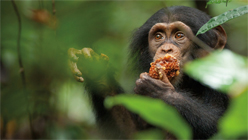It’s a classic scenario in sentimental fiction: An adorable orphan humanizes a crusty old codger. “Humanize” might not seem the obvious verb for what happens in Chimpanzee, Disneynature’s latest kiddie documentary. But it’s dead on; this escape to the planet of the apes is anthropomorphic to a fault.
The story, delivered excitedly by narrator Tim Allen, is about a “precious baby boy,” given the only-in-Hollywood tag of Oscar by filmmakers Alastair Fothergill and Mark Linfield. They call the baby’s mother Isha, and the local chimp patriarch Freddy. The leader of a nearby chimp “mob” that threatens Freddy’s clan is outfitted with the name Scar (although not with Jeremy Irons’ voice).
After Isha’s off-screen death — only partially the fault of Scar and his gang — Oscar is abandoned. None of the other moms in the 35-chimp tribe is prepared to take responsibility for another hungry baby. But before he starves to death, Oscar is adopted by an older male chimp, which is apparently a rare occurrence.
In brief interviews at the movie’s end, the filmmakers say that the story is basically authentic. But even if the narrative’s outline is true, that doesn’t mean the details are accurate. It’s impossible to tell if Allen’s commentary always reflects what the images show.
For example, the movie was shot primarily in the Ivory Coast’s remote Tai Forest. But the filmmakers, who are BBC nature-doc veterans, also worked in Uganda and Gabon. Did the secondary locations yield only the psychedelic time-lapse footage of rain, insects and mutating vegetation? Or are some of the on-screen chimps actually ringers from another jungle altogether?

9(MDAzOTIwODA0MDEyNTA4MTM1OTcyMGJmMA001))

